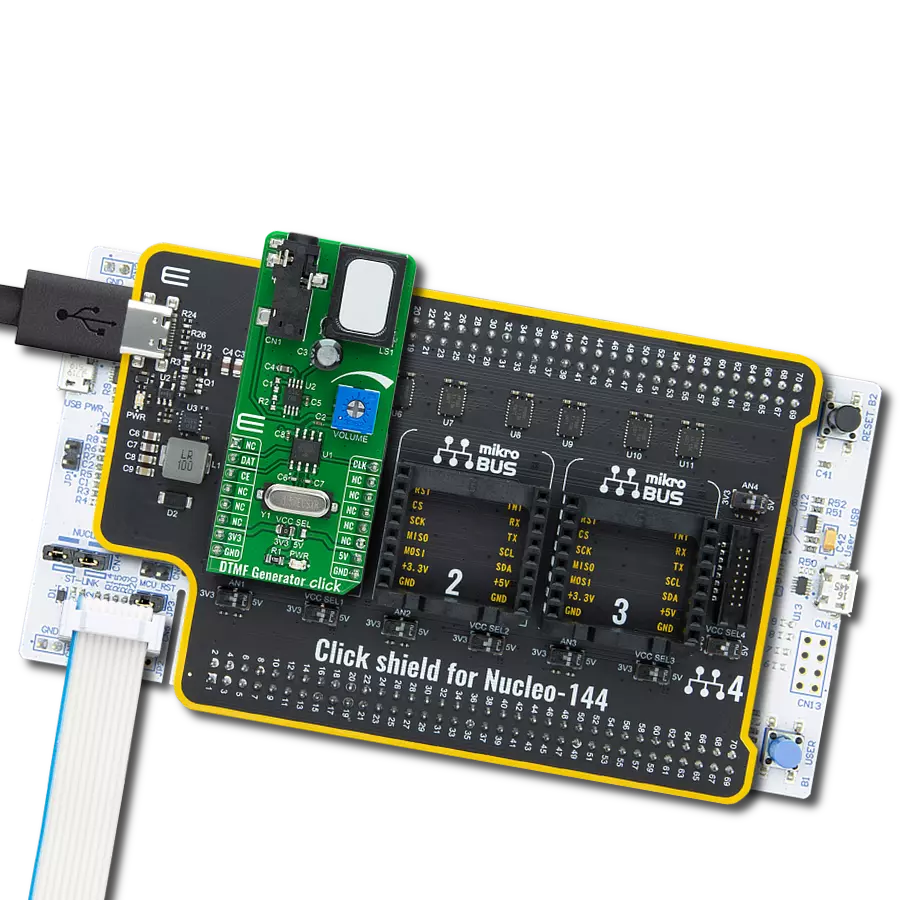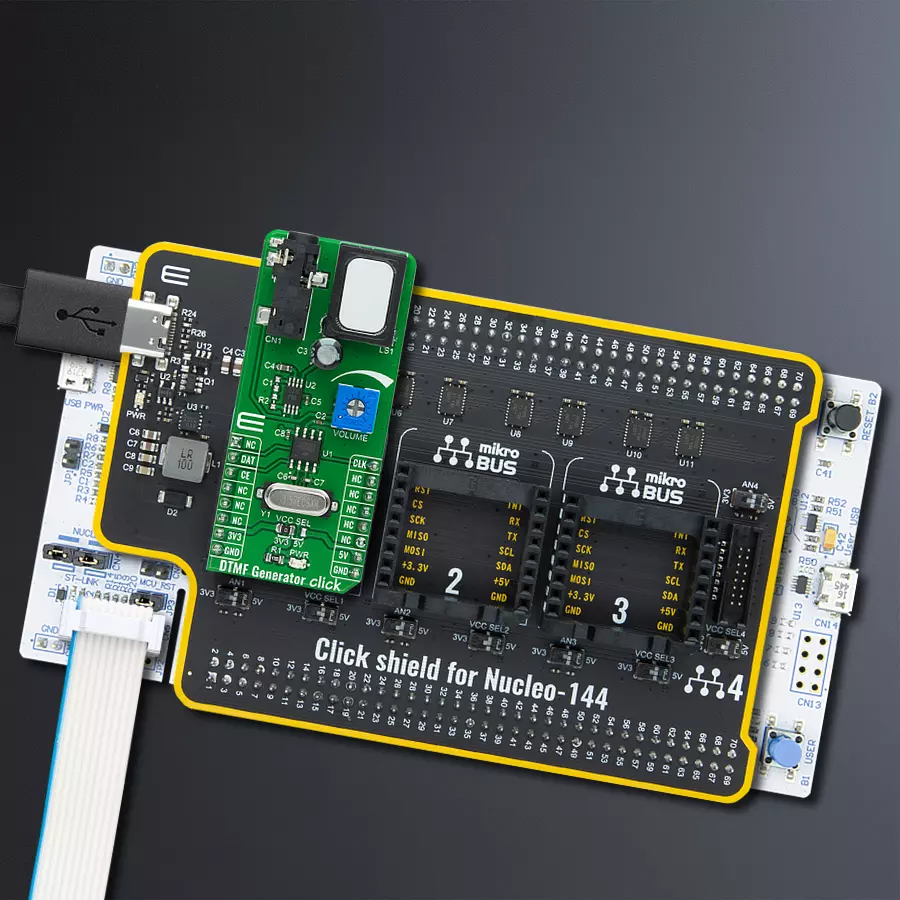Journey into the world of DTMF signal generation, where we uncover the magic that results in the creation of Dual-Tone Multi-Frequency signals vital for mobile communication systems
A
A
Hardware Overview
How does it work?
DTMF Generator Click is based on the HT9200A, a dual-tone multi-frequency decoder from Holtek Semiconductor for mobile communication systems. The HT9200A is an SMD tone generator IC designed for MCU interfaces. It can be instructed by an MCU to generate 16 dual tones and eight single tones from the DTMF pin, and it provides a Serial Mode. The system oscillator of HT9200A consists of an inverter, a bias resistor, and the required load capacitor on a chip. The oscillator function is implemented with a standard 3.579545MHz crystal connected to the X1 and X2 pins of the HT9200A. The operation of the HT9200A is based on GPIO signals fed from the mikroBUS™ to the decoder, DAT, and CLK. There is a connection between the digital codes and the tone output frequency based on the selected desired output frequency. The HT9200A employs a
data input, a 5-bit code, and a synchronous clock to transmit a DTMF signal. Every digit of a transferred number is selected by a series of combinations that consist of 5-bit data. The HT9200A will latch data on the falling edge of the CLK pin and display the output data on its output DTMF pin. Then, via a volume adjustment potentiometer, such a signal is sent to an audio amplifier, the LM386 from Texas Instruments, which represents a mono low-voltage amplifier that can be used in various applications. After the audio amplifier, the desired sound can be detected on the on-board speaker. DTMF Generator Click communicates with MCU using three GPIO pins routed on the CS, RST, and PWM pins of the mikroBUS™ socket labeled CE, DAT, and CLK. CE pin represents the Chip Enable function used to wake up the HT9200A, while DAT
and CLK pins represent data input and synchronous clock input. It also possesses an adjustable potentiometer labeled as VOLUME that adjusts the volume of that signal. It also has a 3.5mm jack output connector that allows the user to use the output DTMF signal in their projects in their way while the signal volume can still be adjusted on the VOLUME potentiometer located on the DTMF Generator Click. This Click board™ can operate with either 3.3V or 5V logic voltage levels selected via the VCC SEL jumper. This way, both 3.3V and 5V capable MCUs can use the communication lines properly. Also, this Click board™ comes equipped with a library containing easy-to-use functions and an example code that can be used as a reference for further development.
Features overview
Development board
Nucleo-144 with STM32L4A6ZG MCU board offers an accessible and adaptable avenue for users to explore new ideas and construct prototypes. It allows users to tailor their experience by selecting from a range of performance and power consumption features offered by the STM32 microcontroller. With compatible boards, the
internal or external SMPS dramatically decreases power usage in Run mode. Including the ST Zio connector, expanding ARDUINO Uno V3 connectivity, and ST morpho headers facilitate easy expansion of the Nucleo open development platform. The integrated ST-LINK debugger/programmer enhances convenience by
eliminating the need for a separate probe. Moreover, the board is accompanied by comprehensive free software libraries and examples within the STM32Cube MCU Package, further enhancing its utility and value.
Microcontroller Overview
MCU Card / MCU

Architecture
ARM Cortex-M4
MCU Memory (KB)
1024
Silicon Vendor
STMicroelectronics
Pin count
144
RAM (Bytes)
327680
You complete me!
Accessories
Click Shield for Nucleo-144 comes equipped with four mikroBUS™ sockets, with one in the form of a Shuttle connector, allowing all the Click board™ devices to be interfaced with the STM32 Nucleo-144 board with no effort. This way, MIKROE allows its users to add any functionality from our ever-growing range of Click boards™, such as WiFi, GSM, GPS, Bluetooth, ZigBee, environmental sensors, LEDs, speech recognition, motor control, movement sensors, and many more. Featuring an ARM Cortex-M microcontroller, 144 pins, and Arduino™ compatibility, the STM32 Nucleo-144 board offers limitless possibilities for prototyping and creating diverse applications. These boards are controlled and powered conveniently through a USB connection to program and efficiently debug the Nucleo-144 board out of the box, with an additional USB cable connected to the USB mini port on the board. Simplify your project development with the integrated ST-Link debugger and unleash creativity using the extensive I/O options and expansion capabilities. This Click Shield also has several switches that perform functions such as selecting the logic levels of analog signals on mikroBUS™ sockets and selecting logic voltage levels of the mikroBUS™ sockets themselves. Besides, the user is offered the possibility of using any Click board™ with the help of existing bidirectional level-shifting voltage translators, regardless of whether the Click board™ operates at a 3.3V or 5V logic voltage level. Once you connect the STM32 Nucleo-144 board with our Click Shield for Nucleo-144, you can access hundreds of Click boards™, working with 3.3V or 5V logic voltage levels.
Used MCU Pins
mikroBUS™ mapper
Take a closer look
Click board™ Schematic

Step by step
Project assembly
Track your results in real time
Application Output
1. Application Output - In Debug mode, the 'Application Output' window enables real-time data monitoring, offering direct insight into execution results. Ensure proper data display by configuring the environment correctly using the provided tutorial.

2. UART Terminal - Use the UART Terminal to monitor data transmission via a USB to UART converter, allowing direct communication between the Click board™ and your development system. Configure the baud rate and other serial settings according to your project's requirements to ensure proper functionality. For step-by-step setup instructions, refer to the provided tutorial.

3. Plot Output - The Plot feature offers a powerful way to visualize real-time sensor data, enabling trend analysis, debugging, and comparison of multiple data points. To set it up correctly, follow the provided tutorial, which includes a step-by-step example of using the Plot feature to display Click board™ readings. To use the Plot feature in your code, use the function: plot(*insert_graph_name*, variable_name);. This is a general format, and it is up to the user to replace 'insert_graph_name' with the actual graph name and 'variable_name' with the parameter to be displayed.

Software Support
Library Description
This library contains API for DTMF Generator Click driver.
Key functions:
dtmfgenerator_set_dat- Set DATA ( RST ) pin state functiondtmfgenerator_power_on- Power ON functiondtmfgenerator_transmit_out_tone- The function transmit duration time of the desired tone
Open Source
Code example
The complete application code and a ready-to-use project are available through the NECTO Studio Package Manager for direct installation in the NECTO Studio. The application code can also be found on the MIKROE GitHub account.
/*!
* @file main.c
* @brief DTMF Generator Click Example.
*
* # Description
* This is an example which demonstrates the use of DTMF Generator Click board.
*
* The demo application is composed of two sections :
*
* ## Application Init
* Initialization driver enables - GPIO,
* run the power-on sequence, also write log.
*
* ## Application Task
* DTMF Generator Click board DTMF generator transmits the signal
* for generating tone for digits :
* "0", "1", "2", "3", "4", "5", "6", "7", "8", "9",
* "A", "B", "C", "D", "*" and "#".
* All data logs write on USB uart changes.
*
* @author Stefan Ilic
*
*/
#include "board.h"
#include "log.h"
#include "dtmfgenerator.h"
static dtmfgenerator_t dtmfgenerator; /**< DTMF Generator Click driver object. */
static log_t logger; /**< Logger object. */
static uint16_t signal_duration = 500;
void application_init ( void ) {
log_cfg_t log_cfg; /**< Logger config object. */
dtmfgenerator_cfg_t dtmfgenerator_cfg; /**< Click config object. */
/**
* Logger initialization.
* Default baud rate: 115200
* Default log level: LOG_LEVEL_DEBUG
* @note If USB_UART_RX and USB_UART_TX
* are defined as HAL_PIN_NC, you will
* need to define them manually for log to work.
* See @b LOG_MAP_USB_UART macro definition for detailed explanation.
*/
LOG_MAP_USB_UART( log_cfg );
log_init( &logger, &log_cfg );
log_info( &logger, " Application Init " );
// Click initialization.
dtmfgenerator_cfg_setup( &dtmfgenerator_cfg );
DTMFGENERATOR_MAP_MIKROBUS( dtmfgenerator_cfg, MIKROBUS_1 );
if ( DIGITAL_OUT_UNSUPPORTED_PIN == dtmfgenerator_init( &dtmfgenerator, &dtmfgenerator_cfg ) ) {
log_error( &logger, " Application Init Error. " );
log_info( &logger, " Please, run program again... " );
for ( ; ; );
}
log_printf( &logger, " Powering on device \r\n" );
log_printf( &logger, "--------------------\r\n" );
dtmfgenerator_power_on( &dtmfgenerator );
Delay_ms ( 1000 );
log_info( &logger, " Application Task " );
}
void application_task ( void ) {
log_printf( &logger, " TONE '0' \r\n");
log_printf( &logger, "---------------\r\n" );
dtmfgenerator_transmit_out_tone( &dtmfgenerator, DTMFGENERATOR_OUT_TONE_0, signal_duration );
dtmfgenerator_transmit_out_tone( &dtmfgenerator, DTMFGENERATOR_OUT_TONE_STOP, signal_duration );
log_printf( &logger, " TONE '1' \r\n");
log_printf( &logger, "---------------\r\n" );
dtmfgenerator_transmit_out_tone( &dtmfgenerator, DTMFGENERATOR_OUT_TONE_1, signal_duration );
dtmfgenerator_transmit_out_tone( &dtmfgenerator, DTMFGENERATOR_OUT_TONE_STOP, signal_duration );
log_printf( &logger, " TONE '2' \r\n");
log_printf( &logger, "---------------\r\n" );
dtmfgenerator_transmit_out_tone( &dtmfgenerator, DTMFGENERATOR_OUT_TONE_2, signal_duration );
dtmfgenerator_transmit_out_tone( &dtmfgenerator, DTMFGENERATOR_OUT_TONE_STOP, signal_duration );
log_printf( &logger, " TONE '3' \r\n");
log_printf( &logger, "---------------\r\n" );
dtmfgenerator_transmit_out_tone( &dtmfgenerator, DTMFGENERATOR_OUT_TONE_3, signal_duration );
dtmfgenerator_transmit_out_tone( &dtmfgenerator, DTMFGENERATOR_OUT_TONE_STOP, signal_duration );
log_printf( &logger, " TONE '4' \r\n");
log_printf( &logger, "---------------\r\n" );
dtmfgenerator_transmit_out_tone( &dtmfgenerator, DTMFGENERATOR_OUT_TONE_4, signal_duration );
dtmfgenerator_transmit_out_tone( &dtmfgenerator, DTMFGENERATOR_OUT_TONE_STOP, signal_duration );
log_printf( &logger, " TONE '5' \r\n");
log_printf( &logger, "---------------\r\n" );
dtmfgenerator_transmit_out_tone( &dtmfgenerator, DTMFGENERATOR_OUT_TONE_5, signal_duration );
dtmfgenerator_transmit_out_tone( &dtmfgenerator, DTMFGENERATOR_OUT_TONE_STOP, signal_duration );
log_printf( &logger, " TONE '6' \r\n");
log_printf( &logger, "---------------\r\n" );
dtmfgenerator_transmit_out_tone( &dtmfgenerator, DTMFGENERATOR_OUT_TONE_6, signal_duration );
dtmfgenerator_transmit_out_tone( &dtmfgenerator, DTMFGENERATOR_OUT_TONE_STOP, signal_duration );
log_printf( &logger, " TONE '7' \r\n");
log_printf( &logger, "---------------\r\n" );
dtmfgenerator_transmit_out_tone( &dtmfgenerator, DTMFGENERATOR_OUT_TONE_7, signal_duration );
dtmfgenerator_transmit_out_tone( &dtmfgenerator, DTMFGENERATOR_OUT_TONE_STOP, signal_duration );
log_printf( &logger, " TONE '8' \r\n");
log_printf( &logger, "---------------\r\n" );
dtmfgenerator_transmit_out_tone( &dtmfgenerator, DTMFGENERATOR_OUT_TONE_8, signal_duration );
dtmfgenerator_transmit_out_tone( &dtmfgenerator, DTMFGENERATOR_OUT_TONE_STOP, signal_duration );
log_printf( &logger, " TONE '9' \r\n");
log_printf( &logger, "---------------\r\n" );
dtmfgenerator_transmit_out_tone( &dtmfgenerator, DTMFGENERATOR_OUT_TONE_9, signal_duration );
dtmfgenerator_transmit_out_tone( &dtmfgenerator, DTMFGENERATOR_OUT_TONE_STOP, signal_duration );
log_printf( &logger, " TONE 'A' \r\n");
log_printf( &logger, "---------------\r\n" );
dtmfgenerator_transmit_out_tone( &dtmfgenerator, DTMFGENERATOR_OUT_TONE_A, signal_duration );
dtmfgenerator_transmit_out_tone( &dtmfgenerator, DTMFGENERATOR_OUT_TONE_STOP, signal_duration );
log_printf( &logger, " TONE 'B' \r\n");
log_printf( &logger, "---------------\r\n" );
dtmfgenerator_transmit_out_tone( &dtmfgenerator, DTMFGENERATOR_OUT_TONE_B, signal_duration );
dtmfgenerator_transmit_out_tone( &dtmfgenerator, DTMFGENERATOR_OUT_TONE_STOP, signal_duration );
log_printf( &logger, " TONE 'C' \r\n");
log_printf( &logger, "---------------\r\n" );
dtmfgenerator_transmit_out_tone( &dtmfgenerator, DTMFGENERATOR_OUT_TONE_C, signal_duration );
dtmfgenerator_transmit_out_tone( &dtmfgenerator, DTMFGENERATOR_OUT_TONE_STOP, signal_duration );
log_printf( &logger, " TONE 'D' \r\n");
log_printf( &logger, "---------------\r\n" );
dtmfgenerator_transmit_out_tone( &dtmfgenerator, DTMFGENERATOR_OUT_TONE_D, signal_duration );
dtmfgenerator_transmit_out_tone( &dtmfgenerator, DTMFGENERATOR_OUT_TONE_STOP, signal_duration );
log_printf( &logger, " TONE '*' \r\n");
log_printf( &logger, "---------------\r\n" );
dtmfgenerator_transmit_out_tone( &dtmfgenerator, DTMFGENERATOR_OUT_TONE_ASTERISK, signal_duration );
dtmfgenerator_transmit_out_tone( &dtmfgenerator, DTMFGENERATOR_OUT_TONE_STOP, signal_duration );
log_printf( &logger, " TONE '#' \r\n");
log_printf( &logger, "---------------\r\n" );
dtmfgenerator_transmit_out_tone( &dtmfgenerator, DTMFGENERATOR_OUT_TONE_HASH, signal_duration );
dtmfgenerator_transmit_out_tone( &dtmfgenerator, DTMFGENERATOR_OUT_TONE_STOP, signal_duration );
}
int main ( void )
{
/* Do not remove this line or clock might not be set correctly. */
#ifdef PREINIT_SUPPORTED
preinit();
#endif
application_init( );
for ( ; ; )
{
application_task( );
}
return 0;
}
// ------------------------------------------------------------------------ END
Additional Support
Resources
Category:Signal Processing



































